Looking for a guide to the different grades of leather? There are so many different kinds of leather out there – full and top grain, genuine and bonded, suede and Nubuck – that figuring out which kind suits your needs, your budget, and your taste can be a serious challenge!
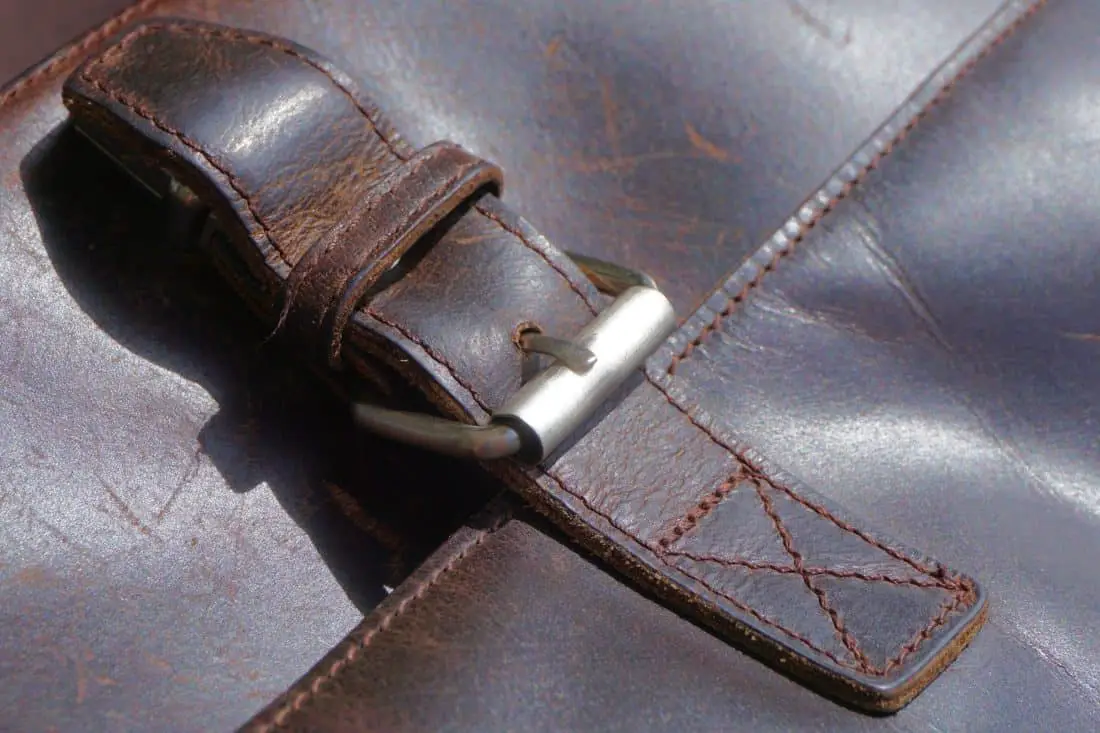
What to Look For
In addition to thinking about quality, you will want to think about what purpose the item you are purchasing is going to serve. Items that must endure most wear and tear, like wallets or belts, need to be durable and strong. In these cases, you’ll want to opt for the highest quality of leather you can afford. That way, your investment will be well-placed.
Wallets and belts made from full grain leather last significantly longer and withstand far more wear and tear compared with lesser quality leather products. If you’re opting for genuine or bonded leather for these products, get ready to replace them quickly when they split or begin to flake away.
For products where a uniform finish is the ideal goal, you may want to sacrifice some strength and durability for a more supple, uniform product. For women’s fine handbags, for instance, you will likely want to opt for top-grain leather. This will give you a soft, beautiful leather product, but beware: treat it kindly! Top grain leathers cannot endure the wear and tear of a full grain leather.
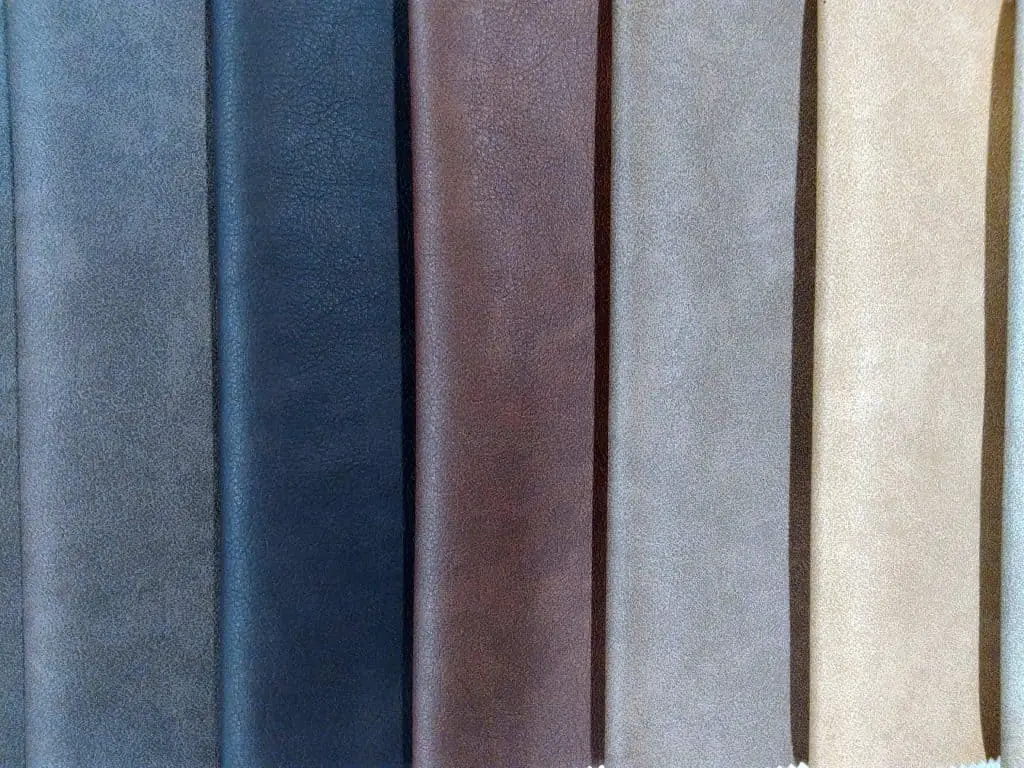
Grades of Leather
Want to know more about how leather quality is determined and what different terminology refers to? We’ve got you covered. Below we’ve outlined the different grades of leather you’re likely to encounter from best to worst quality, with information about processing and terms. For example, how is full grain different from top grain leather? Is there a meaningful distinction between Nubuck and suede? How can you tell if a product is leather or a mixture of leather and bonding agents?
Full Grain Leather
What is “full grain” leather? Simply put, it’s the highest quality grade of leather you can get your hands on. This leather includes the topmost layer of the hide and showcases the natural grain. We know, it seems confusing to call it “full grain” when it’s made from the top of the grain and is the best available leather on the market. But the reason full grain leather has its name is because it is made from the entire grain of the hide–unlike top grain leather, which involves the removal of part of the surface of the skin through sanding or buffing, full grain leather incorporates everything just below the hair.
Full grain leather is more expensive and less supple to work with than other grades of leather, but at the same time it showcases the beautiful natural grain of the animal hide and develops a unique and lovely patina as it ages. The additional labor required to work with full grain leather as opposed to less durable, thinner leathers also makes it cost more for consumers. On the plus side, because it keeps the full grain intact, this grade of leather also has the longest life and best quality: it’s strong and durable and will last for years to come.
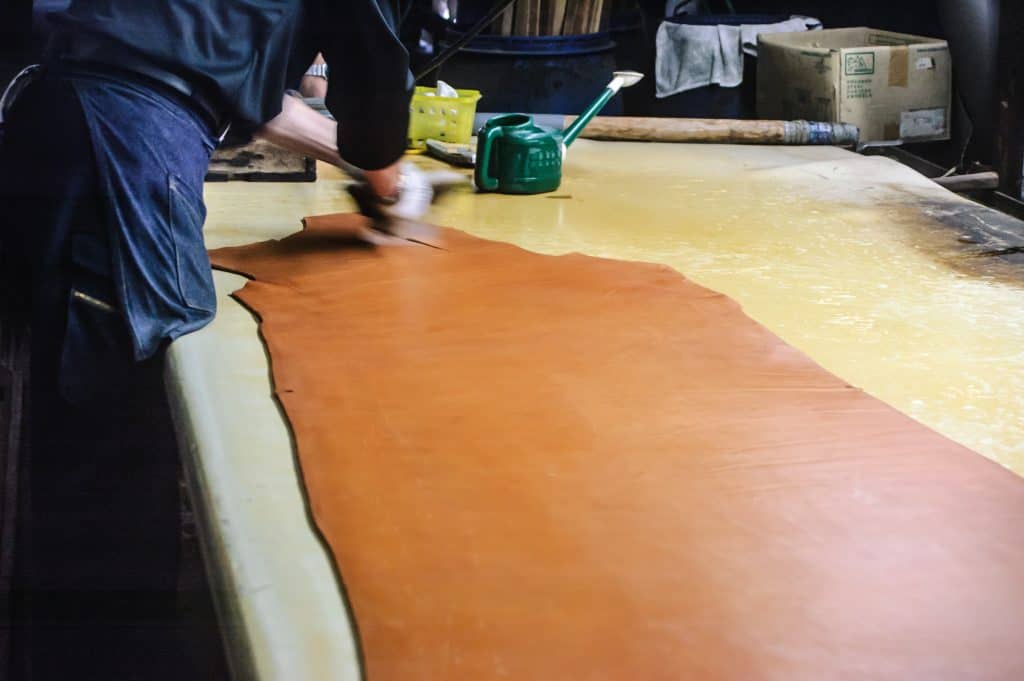
Top Grain Leather
Similar to full grain leather, top grain is among the higher quality leather grades. Unlike its name seems to suggest, however, it is not the top or best quality. “Top grain” refers to its processing rather than its quality. To make top grain leather, the very top layer of the hide, just under the animal’s hair, is sanded, buffed, or shaved off. This makes top grain leather a bit thinner than its full grain cousin, which can have some benefits and some drawbacks.
Unlike full grain leather, which shows the natural grain of the hide (which can vary widely), top grain leather tends to have a more uniform appearance, making it ideal for certain consumer goods that require a uniform appearance and texture, like handbags. Top grain leather tends to be thinner and therefore softer. For the consumer, this is desirable in certain products that receive less than everyday use (or products that are cared for amidst everyday light use).
The fact that top grain leather is thinner also makes it easier for manufacturers to work with. This labor savings gets passed on to consumers, as top grain leather tends to cost somewhat less than full grain leather. That said, it’s also less durable than full grain leather and will not display a unique patina as it ages because the topmost layer of skin has been removed.
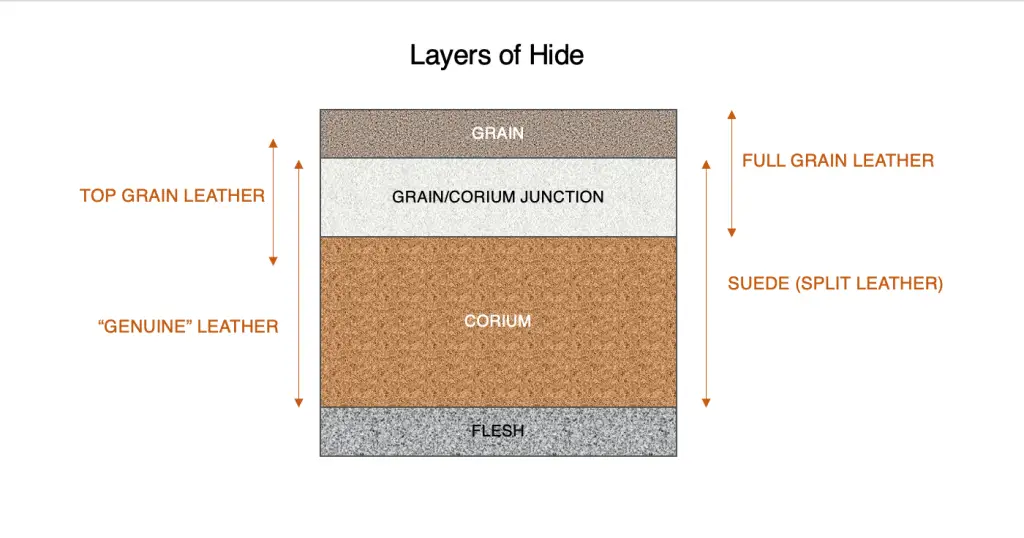
Nubuck and Suede
Nubuck leather is top grain leather that has been sanded or buffed on the grain side to create a napped surface, giving it a different feel than top grain or full grain leather. Typically, the underside of the hide is what is buffed, causing the skin’s proteins to stand on end and giving it a velvety-soft feel. In spite of its different processing, nubuck retains many of the qualities of top grain leather: it is pliable and fairly durable. It is also similar to another, more common type of leather, suede.
When the top grain is separated from the rest of the skin, what’s left is something known as corium. From corium, manufacturers create “split leathers,” many of which wind up as suede. Split leathers tend to be softer than full or top grain leathers, but they are also less durable. In part, this is because split leather is made from subcutaneous layers of skin rather than the outermost layers that must, when they’re part of the animal, withstand weather conditions and life in general.
Most suede is made not from cow leather but lamb, goat, calf, or deer. Its softness and thinness made it a popular choice for women’s gloves (that’s where its name comes from). But its texture and open pores put it at risk for becoming dirty or absorbing liquids, like rain water, extremely easily. Care can be a challenge.
Genuine Leather
At other times, thinner layers of hide are glued together and the top is painted to resemble a higher quality grain. At other times, manufacturers will stamp an artificial grain pattern into genuine leather to make it mimic higher quality leathers. This is often highlighted with an artificial finish of some type, including stains or dyes.
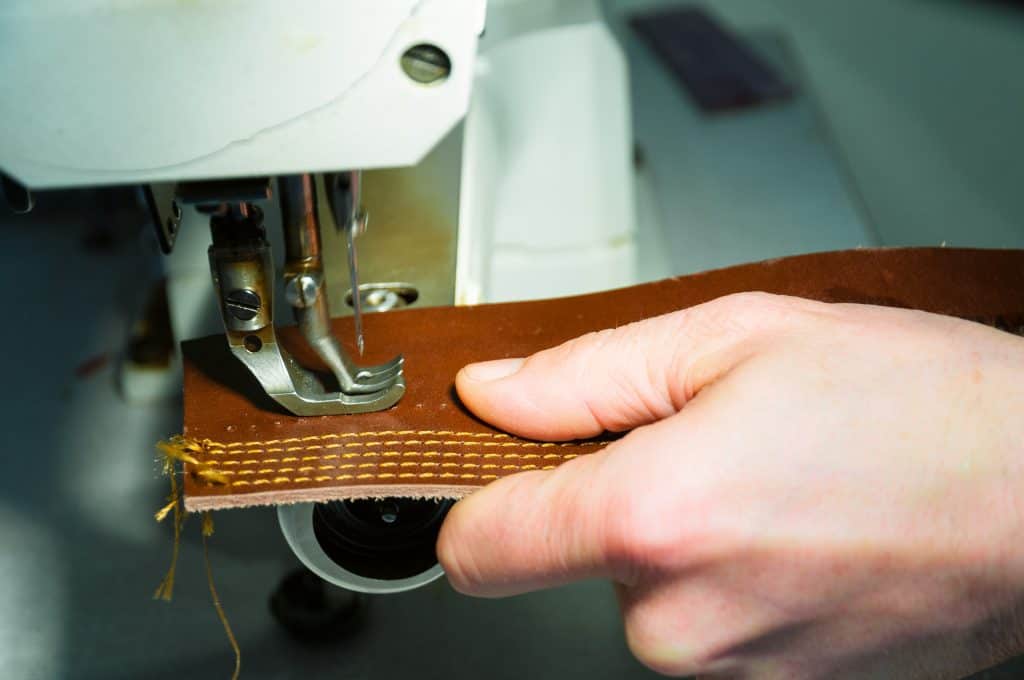
Genuine leather can also be referred to as “corrected grain” leather. Corrected grain leather is leather subjected to various finishing treatments to yield a more uniform appearance. Imperfections in the hide are buffed or sanded away, while the remaining surface is typically dyed and/or embossed. If you see “alligator hide,” for example, and it is not made from 100% alligator, chances are alligator skin has been attached to a correct grain cow leather.
We’ve seen some Genuine Leather that’s “okay” – i.e., not heirloom quality, but you’ll get a couple years out of it. This Flyhawk Wallet is a great example of that.
Genuine leather might sound great, but it is actually one of the lowest qualities of leather! (Marketers, huh?) Typically, genuine leather does not last as long nor look as nice as higher quality full or top grain leathers. It is made from the leftover layer from higher quality leather production. When the upper layer is taken for top grain and the lower layer for suede, what’s leftover can be referred to as “genuine leather.”
Bonded Leather
Hint – run far and fast from this “leather”! While genuine leather still uses full sheets of leftover hide, bonded leather (otherwise known as reconstituted or blended leather) takes things a step further and uses small pieces of leftover leather and combines them into one large piece using a chemical bonding agent. You might think of it like the particle board or hot dog version of leather.
As with particle boards and hot dogs, smaller scraps are ground up and then mixed together. In the case of bonded leather, leather scraps are combined with a bonding agent, such as latex or polyurethane. Then, this mixture is bonded on a fiber sheet and stamped with a leather grain pattern to make it look like the real thing. Bonded leather is popular for book covers, upholstery, and other low-priced products.
There’s little regulation in terms of the leather scrap to bonding agent ratio, so the durability and consistency of bonded leather varies widely. On the whole, however, it is neither as durable nor long lasting as higher quality leathers, and you should avoid purchasing high use items made from bonded leather as it will break down and you’ll wish you opted for the pricier alternative. With wear, bonded leather often peels or flakes away as the bonding agent gives way and the individual leather scraps break loose.
If you’re in doubt, trust your nose. The bonding agents used in both bonded and genuine leather often have a chemical smell. Whereas top and full grain leathers will smell natural, even earthy, genuine and bonded leathers often have a chemical odor that gives them away.
Leather Grades – Wrap Up
The key with choosing any leather type is thinking about the quality you need, the price you want to pay, and the finish that fits your tastes. There’s pros and cons to every grade of leather (except bonded leather – we encourage you to avoid this at all costs!), but being a more informed consumer can help you find the leather grade that fits your individual needs.
All product names, logos, brands, and trademarks are the property of their respective owners
